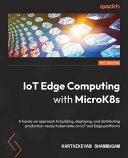Product desciption
Iot Edge Computing With Microk8s Karthikeyan Shanmugam by Karthikeyan Shanmugam 9781803230634, 1803230630 instant download after payment.
A step-by-step, comprehensive guide that includes real-world use cases to help you successfully develop and run applications and mission-critical workloads using MicroK8s Key Features: An easy-to-follow guide that helps you get started with MicroK8s and other Kubernetes components Understand the key concepts and constraints for building IoT and edge architectures Get guidance on how to develop and deploy use cases and examples on IoT and edge computing platforms Book Description: Are you facing challenges with developing, deploying, monitoring, clustering, storing, securing, and managing Kubernetes in production environments as you're not familiar with infrastructure technologies? MicroK8s - a zero-ops, lightweight, and CNCF-compliant Kubernetes with a small footprint is the apt solution for you. This book gets you up and running with production-grade, highly available (HA) Kubernetes clusters on MicroK8s using best practices and examples based on IoT and edge computing. Beginning with an introduction to Kubernetes, MicroK8s, and IoT and edge computing architectures, this book shows you how to install, deploy sample apps, and enable add-ons (like DNS and dashboard) on the MicroK8s platform. You'll work with multi-node Kubernetes clusters on Raspberry Pi and networking plugins (such as Calico and Cilium) and implement service mesh, load balancing with MetalLB and Ingress, and AI/ML workloads on MicroK8s. You'll also understand how to secure containers, monitor infrastructure and apps with Prometheus, Grafana, and the ELK stack, manage storage replication with OpenEBS, resist component failure using a HA cluster, and more, as well as take a sneak peek into future trends. By the end of this book, you'll be able to use MicroK8 to build and implement scenarios for IoT and edge computing workloads in a production environment. What You Will Learn: Get a holistic view of MicroK8s features using a sample application Understand IoT and edge computing and their architecture constraints Create, scale, and update HA Raspberry Pi multi-node clusters Implement AI/ML use cases with the Kubeflow platform Work with various networking plugins, and monitoring and logging tools Perform service mesh integrations using Istio and Linkerd Run serverless applications using Knative and OpenFaaS frameworks Secure your containers using Kata and strict confinement options Who this book is for: This book is for DevOps and cloud engineers, SREs, and application developers who want to implement efficient techniques for deploying their software solutions. It will also be useful for technical architects and technology leaders who are looking to adopt cloud-native technologies. A basic understanding of container-based application design and development, virtual machines, networking, databases, and programming will be helpful for using this book.


